Ballet shoes
Ballet shoes, or ballet slippers, are lightweight shoes designed specifically for ballet dancing. They are made from soft leather, canvas, or satin, and have flexible, thin soles. Ballet shoes are typically available in pink, black, gray, or white. Traditionally, women wear pink shoes and men wear white, while flesh or tan colored shoes-which are unobtrusive and thus give the appearance of dancing barefoot-are worn by both men and women.
Beginning ballet dancers, and ballet dancers younger than approximately twelve years old, wear ballet shoes exclusively while training and performing, whereas more advanced female dancers may wear ballet shoes or pointe shoes as circumstances require. Young dancers are typically restricted to ballet shoes until their bones are ossified and their muscles are sufficiently strong to dance en pointe. Male dancers almost always wear soft ballet shoes, as they rarely dance en pointe.
Ballet schools typically conduct technique classes, in which dancers wear only ballet shoes, and pointe classes in which students first wear ballet shoes to warm up at the barre, and then change to pointe shoes for the center exercises. Many ballet schools require at least five years of training before allowing their dancers to go en pointe.
Construction
Like many other types of dance shoes, ballet shoes may have either split-sole (for enhanced flexibility) or full-sole construction. They are usually made from soft leather, canvas or satin:
- Leather shoes are long-lasting and help to keep the feet warm. High grain leather shoes are typically the most flexible and comfortable, and also the most expensive.
- Canvas shoes are typically worn by men. They cost less than leather ballet shoes and the canvas enables the foot to "breathe," but it wears faster than leather.
- Satin shoes, which are typically worn by women, are easily dyed to customize the shoe color.
Elastic bands are used to help to secure ballet shoes to the feet. Each shoe may be secured either with a single band across the arch of the foot, or with two bands that cross in an "X" shape at the top of the arch. Split-sole shoes typically employ two bands, while single-sole shoes usually have just one. In the case of single bands, most ballet shoe manufacturers attach the bands to the shoes during the manufacturing process. In the case of double band shoes, manufacturers will typically attach one end of each band to the shoe and leave it to the purchaser to attach the free ends of the bands for optimal fit.
See also
| Shoes | |
| Boots | |
| Types of heel | |
Chat rooms • What links here • Copyright info • Contact information • Category:Root
